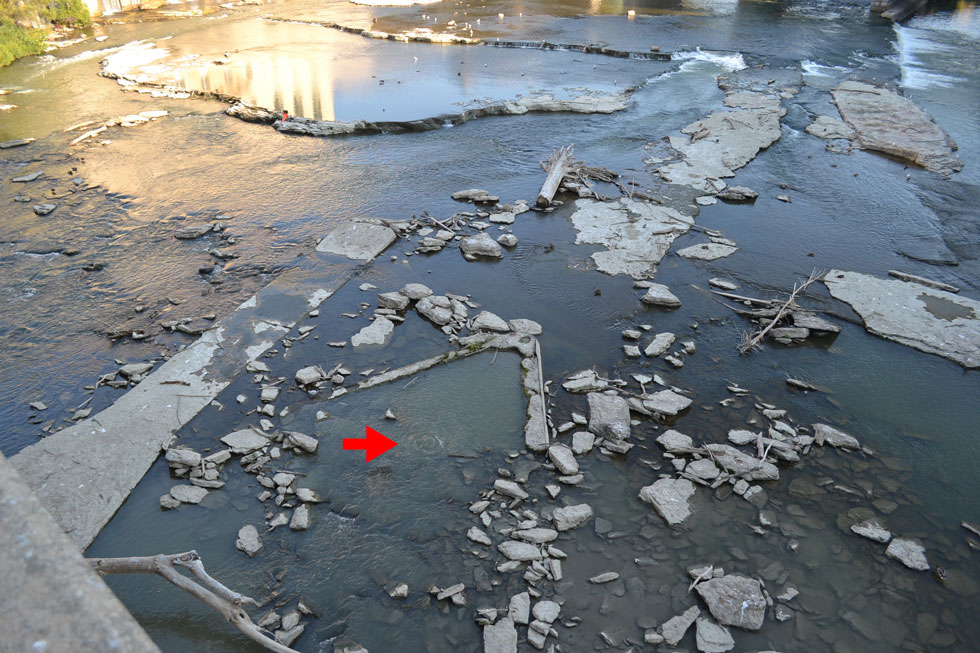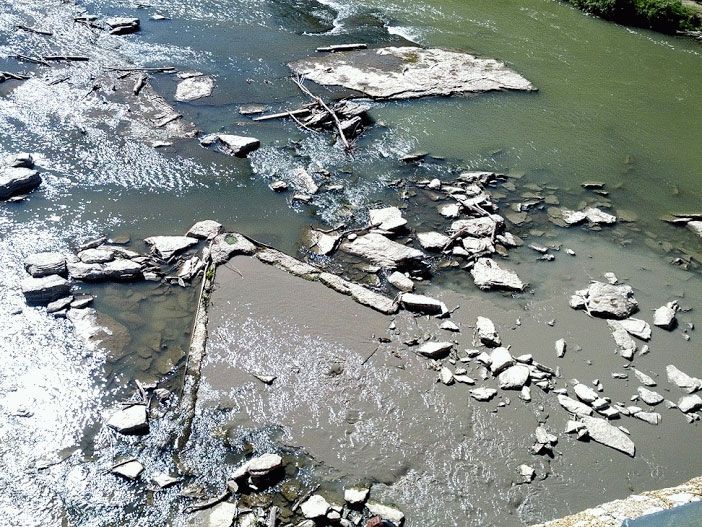This article was scraped from Rochester Subway. This is a blog about Rochester history and urbanism has not been published since 2017. The current owners are now publishing link spam which made me want to preserve this history.. The original article was published September 27, 2013 and can be found here.
![I have seen these concrete triangles in the river before. But I had never noticed the spring water bubbling up. What is this strange water feature? [PHOTO: Michael Krauklis]](https://senseofplace.dev/content/images/photos/genesee-river-triangle-rochester.jpg)
Last week a reader, Michael Krauklis, sent me this picture and asked two perplexing questions. Michael said, "I've worked downtown just next to the Broad Street bridge for 11 years now, and the entire time there has been a strange feature in the river just south of the bridge

. Upon first glance it appears to be a spring, in the middle of the river, but with further inspection one can see the carcass of an old abandoned structure surrounding it... What was the original purpose of this and where is the water is coming from?"
I have seen these strange concrete triangles in the river myself, and I know there are more than one of them. But I had never noticed the spring water bubbling up! In either case, I had no good answer for Michael. So, I started digging. Here's what I found out...
Thomas Hack, Chief Structural Engineer with the City of Rochester tells me he's looked into these mysterious triangles before too. He says, "They appear to be cofferdams that were used for a variety of reason in the early 1900's. The main purpose was to de-water Genesee River when they were blasting the rock profile back in 1905. They needed to keep the excavation somewhat dry so they erected these concrete cofferdams."
Here are some archival photos that show what this excavation process looked like...
![Here a workman poses with his steam drill under the Broad Street Bridge. Explosives will be used to deepen the river bed. [PHOTO: Albert R. Stone]](https://senseofplace.dev/content/images/photos/genesee-river-excavation-01.jpg)
Here a workman poses with his steam drill under the Broad Street Bridge, shortly before the first explosive blast is to be touched off. The river has been drained and will be deepened to help prevent future floods in downtown Rochester. Take note of those holes he's drilling.
![Concrete flows down a chute from a concrete mixer on the Andrews Street Bridge. It flows into wheeled hoppers that move on railroad tracks to the work area. [PHOTO: Albert R. Stone]](https://senseofplace.dev/content/images/photos/genesee-river-excavation-02.jpg)
Concrete flows down a chute from a concrete mixer on the Andrews Street Bridge. It flows into wheeled hoppers that move on railroad tracks to the work area.
![Men work from narrow wooden platforms filling concrete forms with sand bags. [PHOTO: Albert R. Stone]](https://senseofplace.dev/content/images/photos/genesee-river-excavation-03.jpg)
Men work from narrow wooden platforms filling concrete forms with sand bags.
![Three workmen push a hopper along a raised trestle in the middle of the Genesee River. [PHOTO: Albert R. Stone]](https://senseofplace.dev/content/images/photos/genesee-river-excavation-04.jpg)
Three workmen push a hopper along a raised trestle in the middle of the Genesee River. The hopper moves along a set of tracks located between the Andrews Street Bridge, where a concrete mixer waits.
![Diver Pat Welch goes down in the Genesee River bed to check for leaks in the walls of the cofferdams. [PHOTO: Albert R. Stone]](https://senseofplace.dev/content/images/photos/genesee-river-excavation-06.jpg)
Diver Pat Welch goes down in the Genesee River bed to check for leaks in the walls of the cofferdams. The cofferdams will keep part of the riverbed dry for the river deepening project.
![There's Pat. [PHOTO: Albert R. Stone]](https://senseofplace.dev/content/images/photos/genesee-river-excavation-05.jpg)
There's Pat.

Okay, so that sounds like a reasonable explanation for triangles. But why is this one spewing water like a natural spring? To find out, I turned to Bill Chaisson. Bill holds a Ph.D. in Geology. When I showed him the photos he immediately recognized it as the "Artesian effect." AH HA!
Uh... dur... what the hell is the Artesian effect?
When water flows out of the ground on its own, without pumping, that is known as an Artesian Well. The name "Artesian" is derived from Artois, France, where such wells were sunk as early as 1126.
![The Artesian effect is one possible explanation for the natural spring. [IMAGE: RochesterSubway.com]](https://senseofplace.dev/content/images/photos/genesee-river-water-artesian-spring.jpg)
In this particular case, Bill explains, "the water piled up behind the Court Street dam is being forced downward into fractures (joints, or other connected cavities) behind the dam."
The water works its way down into permeable rock, like limestone or sandstone, underneath the damn. This porous stone is sandwiched between a top and bottom layer of impermeable clay or shale rock which keeps the water pressure high. So wherever that water can find an opening, "it will gurgle up" to the surface.
Remember the photo of the workers drilling into the river bed? Those holes have provided an escape route for the pressurized water beneath the rock... and VOILA!! Rochester has its very own Artesian Well.
Fascinating! Thanks to Tom Hack and Bill Chaisson. And thanks to Michael K. for asking the tough questions.
UPDATE: A commenter on Facebook pointed out another triangle at the Sister Cities pedestrian bridge. It seems this one was part of a fountain that worked for a few months in the late 1960's when the bridge was new. It clogged with silt and stopped working. The triangle discussed in this post is from a much earlier time period. It can be seen in photos from the early 1920's.


